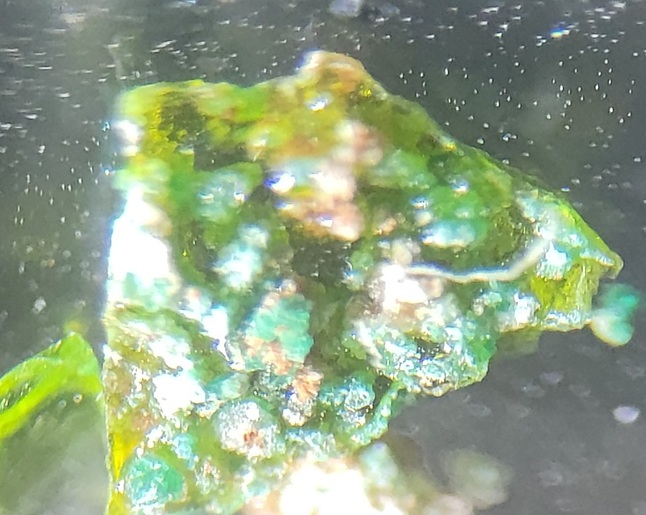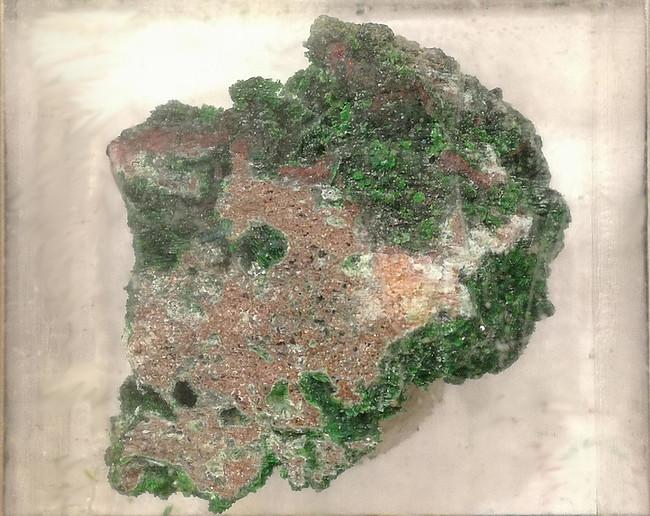Ponomarevite
A valid IMA mineral species
This page is currently not sponsored. Click here to sponsor this page.
About Ponomarevite
Formula:
K4Cu4Cl10O
Colour:
Red with a gold tint
Lustre:
Vitreous, Resinous, Greasy
Hardness:
2½
Crystal System:
Monoclinic
Name:
Named in honor of Vasilii Vasil’evich Ponomarev (Василий Васильевич Пономарев) (1940–1976), Russian vulcanologist, Institute of Volcanology, who studied the Tolbachik Volcano.
This page provides mineralogical data about Ponomarevite.
Unique Identifiers
Mindat ID:
3263
Long-form identifier:
mindat:1:1:3263:2
GUID
(UUID V4):
(UUID V4):
67b373cc-b5d6-4d35-9bff-e10de9a9181f
IMA Classification of Ponomarevite
Approved
IMA Formula:
K4Cu4OCl10
First published:
1988
Classification of Ponomarevite
3.DA.35
3 : HALIDES
D : Oxyhalides, hydroxyhalides and related double halides
A : With Cu, etc., without Pb
3 : HALIDES
D : Oxyhalides, hydroxyhalides and related double halides
A : With Cu, etc., without Pb
10.6.12.1
10 : OXYHALIDES AND HYDROXYHALIDES
6 : AmBn(O,OH)pXq
10 : OXYHALIDES AND HYDROXYHALIDES
6 : AmBn(O,OH)pXq
8.2.13
8 : Halides - Fluorides, Chlorides, Bromides and Iodides; also Fluoborates and Fluosilicates
2 : Halides of Cu
8 : Halides - Fluorides, Chlorides, Bromides and Iodides; also Fluoborates and Fluosilicates
2 : Halides of Cu
Mineral Symbols
As of 2021 there are now IMA–CNMNC approved mineral symbols (abbreviations) for each mineral species, useful for tables and diagrams.
| Symbol | Source | Reference |
|---|---|---|
| Pon | IMA–CNMNC | Warr, L.N. (2021). IMA–CNMNC approved mineral symbols. Mineralogical Magazine, 85(3), 291-320. doi:10.1180/mgm.2021.43 |
Physical Properties of Ponomarevite
Vitreous, Resinous, Greasy
Transparency:
Transparent
Comment:
Vitreous on cleavages, resinous to greasy on aggregates
Colour:
Red with a gold tint
Streak:
Orange-red
Hardness:
2½ on Mohs scale
Hardness:
VHN10=71 kg/mm2 - Vickers
Tenacity:
Brittle
Cleavage:
Imperfect/Fair
Parallel to {001}, also {110}
Parallel to {001}, also {110}
Optical Data of Ponomarevite
Type:
Biaxial (-)
RI values:
nα = 1.686 nβ = 1.718 nγ = 1.720
2V:
Measured: 28° (5), Calculated: 26°
Max Birefringence:
δ = 0.034

Image shows birefringence interference colour range (at 30µm thickness)
and does not take into account mineral colouration.
and does not take into account mineral colouration.
Surface Relief:
High
Dispersion:
r > v
Optical Extinction:
Y = b; X ∧ c = 30◦
Pleochroism:
Non-pleochroic
Chemistry of Ponomarevite
Mindat Formula:
K4Cu4Cl10O
Elements listed:
Crystallography of Ponomarevite
Crystal System:
Monoclinic
Class (H-M):
2/m - Prismatic
Space Group:
B2/b
Setting:
C2/c
Cell Parameters:
a = 14.740(3) Å, b = 14.900(3) Å, c = 8.948(2) Å
β = 104.9(1)°
β = 104.9(1)°
Ratio:
a:b:c = 0.989 : 1 : 0.601
Unit Cell V:
1,899.14 ų (Calculated from Unit Cell)
Z:
4
Morphology:
Pseudohexagonal plates with {104} and {010} pinacoids and {530} prism.
Comment:
Data from Semenova, et al. (1989)
Crystal Structure
Load
Unit Cell | Unit Cell Packed
2x2x2 | 3x3x3 | 4x4x4
Unit Cell | Unit Cell Packed
2x2x2 | 3x3x3 | 4x4x4
Show
Big Balls | Small Balls | Just Balls | Spacefill
Polyhedra Off | Si Polyhedra | All Polyhedra
Remove metal-metal sticks
Big Balls | Small Balls | Just Balls | Spacefill
Polyhedra Off | Si Polyhedra | All Polyhedra
Remove metal-metal sticks
Display Options
Black Background | White Background
Perspective On | Perspective Off
2D | Stereo | Red-Blue | Red-Cyan
Black Background | White Background
Perspective On | Perspective Off
2D | Stereo | Red-Blue | Red-Cyan
View
CIF File Best | x | y | z | a | b | c
CIF File Best | x | y | z | a | b | c
Rotation
Stop | Start
Stop | Start
Labels
Console Off | On | Grey | Yellow
Console Off | On | Grey | Yellow
Data courtesy of the American Mineralogist Crystal Structure Database. Click on an AMCSD ID to view structure
| ID | Species | Reference | Link | Year | Locality | Pressure (GPa) | Temp (K) |
|---|---|---|---|---|---|---|---|
| 0009464 | Ponomarevite | de Boer J J, Bright D, Helle J N (1972) The structure of the potassium salt of mu4-oxo-hexa-mu-chloro- tetra[chlorocuprate(II)], K4Cu4OCl10 Acta Crystallographica B28 3436-3437 |  | 1972 | synthetic | 0 | 293 |
| 0012479 | Ponomarevite | Semenova T F, Rozhdestvenskaya I V, Filatov S K, Verasova L P (1989) Crystal structure of a new mineral ponomarevite, K4Cu4OCl10 Doklady Akademii Nauk SSSR 304 427-430 | 1989 | the main Tolbachik fissure eruption (1975-76), Kamchatka | 0 | 293 |
CIF Raw Data - click here to close
X-Ray Powder Diffraction
Powder Diffraction Data:
| d-spacing | Intensity |
|---|---|
| 2.801 Å | (100) |
| 7.31 Å | (80) |
| 2.787 Å | (80) |
| 6.074 Å | (70) |
| 2.470 Å | (65) |
| 3.654 Å | (60) |
| 3.048 Å | (60) |
Geological Environment
Paragenetic Mode(s):
| Paragenetic Mode | Earliest Age (Ga) |
|---|---|
| Stage 7: Great Oxidation Event | <2.4 |
| 45b : [Other oxidized fumarolic minerals] |
Type Occurrence of Ponomarevite
General Appearance of Type Material:
Cement and as a crust, 1-2 cm in thickness, having nodular (0.1 to 0.3 cm in diameter) and skeletal forms. Microscopic psuedohexagonal plates.
Place of Conservation of Type Material:
Mining Institute, St. Petersburg, Russia, 1483/1.
Geological Setting of Type Material:
Fumarole
Associated Minerals at Type Locality:
Reference:
Vergasova, L.P., Filatov, S.K., Serafimova, E.K., Semenova, T.F. (1988) Ponomarevite K4Cu4OCl10 - a new mineral from volcanic sublimates. Doklady Akademii Nauk SSSR: 300: 1197-1200.
Synonyms of Ponomarevite
Other Language Names for Ponomarevite
Common Associates
Associated Minerals Based on Photo Data:
| 1 photo of Ponomarevite associated with Klyuchevskite | K3Cu3(Fe3+,Al)(SO4)4O2 |
Related Minerals - Strunz-mindat Grouping
| 3.DA. | Centennialite | CaCu3Cl2(OH)6 · nH2O (n ~ 0.7) |
| 3.DA. | Muonionalustaite | Ni3(OH)4Cl2 · 4H2O |
| 3.DA. | Parahibbingite | Fe2(OH)3Cl |
| 3.DA. | Bounahasite | Cu+Cu2+2(OH)3Cl2 |
| 3.DA.05 | Melanothallite | Cu2Cl2O |
| 3.DA.10a | Atacamite | Cu2(OH)3Cl |
| 3.DA.10b | Botallackite | Cu2(OH)3Cl |
| 3.DA.10b | Clinoatacamite | Cu2(OH)3Cl |
| 3.DA.10a | Hibbingite | Fe2+2(OH)3Cl |
| 3.DA.10a | Kempite | Mn2+2(OH)3Cl |
| 3.DA.10c | Kuliginite | Fe3Mg(OH)6Cl2 |
| 3.DA.10c | Paratacamite | Cu3(Cu,Zn)(OH)6Cl2 |
| 3.DA.10b | Belloite | Cu(OH)Cl |
| 3.DA.10c | Herbertsmithite | Cu3Zn(OH)6Cl2 |
| 3.DA.10c | Kapellasite | Cu3Zn(OH)6Cl2 |
| 3.DA.10c | Gillardite | Cu3Ni(OH)6Cl2 |
| 3.DA.10c | Haydeeite | Cu3Mg(OH)6Cl2 |
| 3.DA.10c | Leverettite | Cu3Co(OH)6Cl2 |
| 3.DA.10c | Paratacamite-(Ni) | Cu3(Ni,Cu)(OH)6Cl2 |
| 3.DA.10c | Tondiite | Cu3Mg(OH)6Cl2 |
| 3.DA.10c | Misakiite | Cu3Mn(OH)6Cl2 |
| 3.DA.10b | Iyoite | MnCuCl(OH)3 |
| 3.DA.10b | Unnamed (Cu-Zn Chloride Hydroxide) | CuZnCl(OH)3 |
| 3.DA.15 | Claringbullite | Cu4ClF(OH)6 |
| 3.DA.15 | Barlowite | Cu4BrF(OH)6 |
| 3.DA.20 | Simonkolleite | Zn5Cl2(OH)8 · H2O |
| 3.DA.25 | Buttgenbachite | Cu19(NO3)2(OH)32Cl4 · 2H2O |
| 3.DA.25 | Connellite | Cu19(SO4)(OH)32Cl4 · 3H2O |
| 3.DA.30 | Abhurite | Sn21Cl16(OH)14O6 |
| 3.DA.40 | Anthonyite | Cu(OH,Cl)2 · 3H2O |
| 3.DA.40 | Calumetite | CaCu4(OH)8Cl2 · 3.5H2O |
| 3.DA.45 | Khaidarkanite | Cu4Al3(OH)14F3 · 2H2O |
| 3.DA.50 | Bobkingite | Cu5Cl2(OH)8 · 2H2O |
| 3.DA.55 | Avdoninite | K2Cu5(OH)4Cl8 · H2O |
| 3.DA.60 | Droninoite | Ni6Fe3+2(OH)16Cl2 · 4H2O |
| 3.DA.70 | Chrysothallite | K6Cu6Tl3+Cl17(OH)4 · H2O |
| 3.DA.70 | Dioskouriite | CaCu4Cl6(OH)4 · 4H2O |
| 3.DA.75 | Feodosiyite | Cu11Mg2Cl18(OH)8 · 16H2O |
| 3.DA.80 | Romanorlovite | K8Cu6Cl17(OH)3 |
Other Information
Health Risks:
No information on health risks for this material has been entered into the database. You should always treat mineral specimens with care.
Internet Links for Ponomarevite
mindat.org URL:
https://www.mindat.org/min-3263.html
Please feel free to link to this page.
Please feel free to link to this page.
Search Engines:
External Links:
Mineral Dealers:
References for Ponomarevite
Reference List:
Localities for Ponomarevite
Locality List
 - This locality has map coordinates listed.
- This locality has map coordinates listed.
 - This locality has estimated coordinates.
ⓘ - Click for references and further information on this occurrence.
? - Indicates mineral may be doubtful at this locality.
- This locality has estimated coordinates.
ⓘ - Click for references and further information on this occurrence.
? - Indicates mineral may be doubtful at this locality.
 - Good crystals or important locality for species.
- Good crystals or important locality for species.
 - World class for species or very significant.
(TL) - Type Locality for a valid mineral species.
(FRL) - First Recorded Locality for everything else (eg varieties).
- World class for species or very significant.
(TL) - Type Locality for a valid mineral species.
(FRL) - First Recorded Locality for everything else (eg varieties).
All localities listed without proper references should be considered as questionable.
Russia (TL) | |
| DAN-SSSR (1988) +2 other references |
| Vergasova et al. (2000) |
| Pekov (1998) |
Quick NavTopAbout PonomareviteUnique IdentifiersIMA Classification Classification Mineral SymbolsPhysical Properties Optical Data Chemistry Crystallography Crystal StructureX-Ray Powder DiffractionGeological EnvironmentType Occurrence SynonymsOther LanguagesCommon AssociatesStrunz-MindatOther InformationInternet Links References Localities Locality List





 symbol to view information about a locality.
The
symbol to view information about a locality.
The 



Tolbachik Volcanic field, Milkovsky District, Kamchatka Krai, Russia